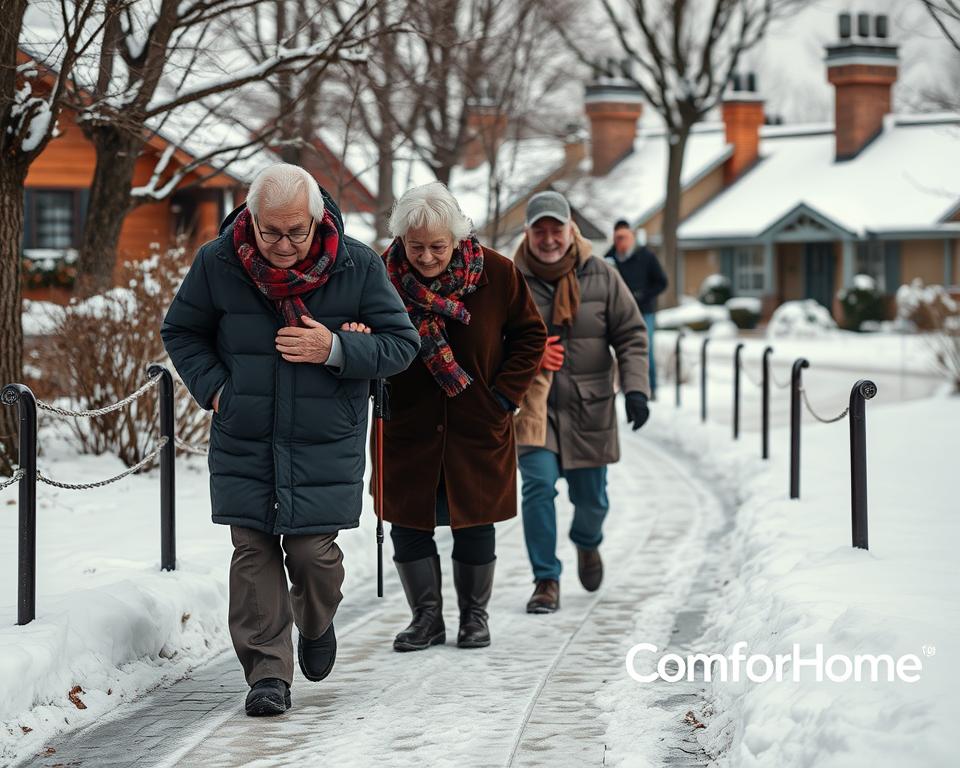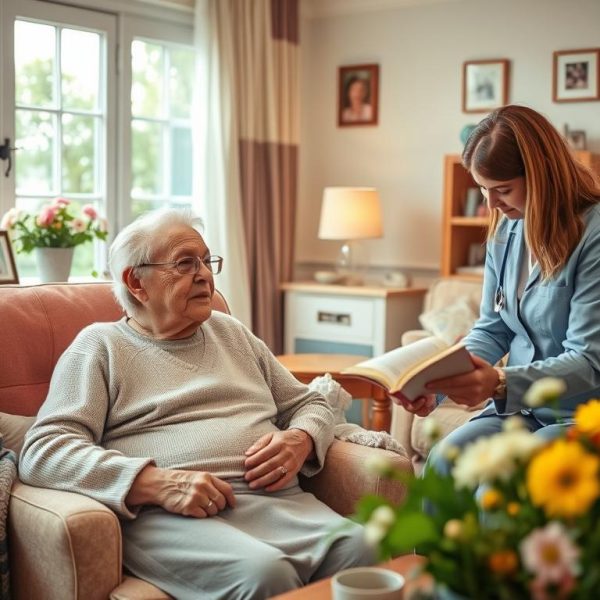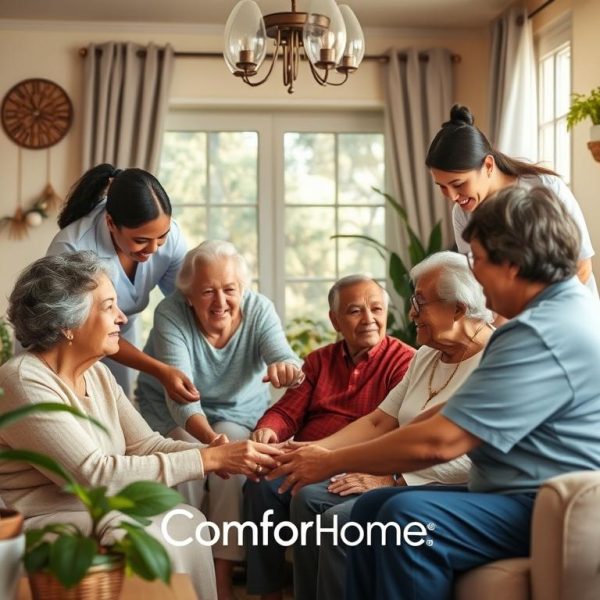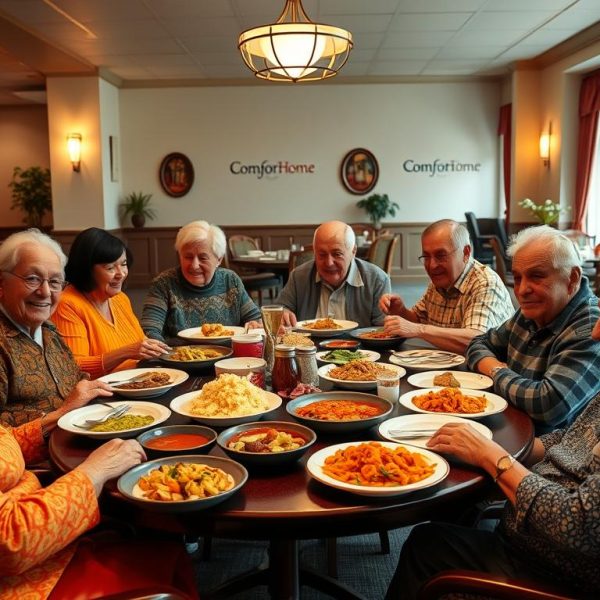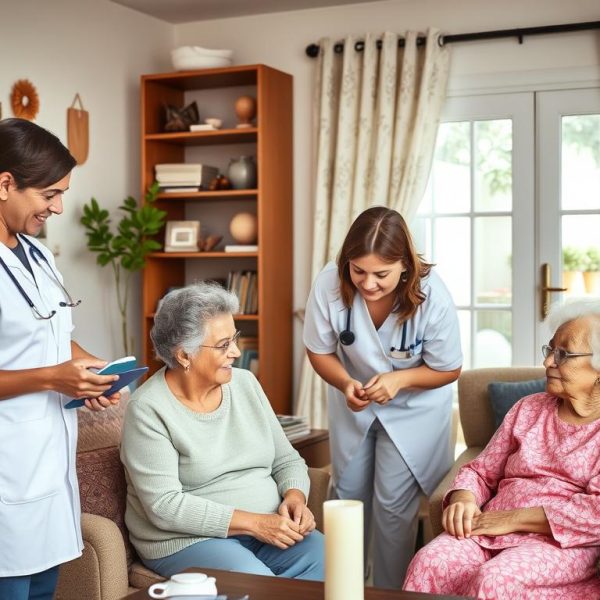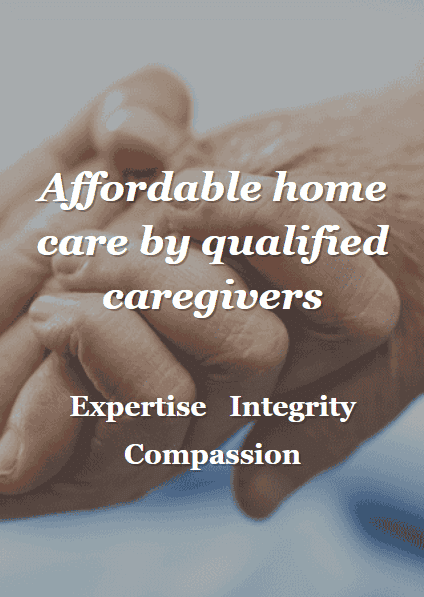Winter’s cold air brings a silent concern for our elderly loved ones. The beauty of snow hides the dangers it poses, making it a risk for seniors. Each snowflake reminds us of the need for elderly winter safety precautions.
The cold season brings extra risks and challenges for the elderly. We must take care of them with great responsibility. As health guardians and caretakers, we carry this duty with care.
Winter’s cold doesn’t care if it’s a leaf or an elderly person’s skin. Conditions like diabetes and memory disorders make them more vulnerable. About 20% of older adults face these challenges, making winter care for elderly parents crucial.
Elders face a new kind of trial in winter. Cold hands can be a serious sign. We must dress them warmly, heat their homes, and protect them from wind.
Winter also brings a silent threat of isolation. Cold weather can lead to loneliness and sadness among seniors. We must be there for them, offering warmth and safety.
These actions are not just suggestions. They are essential to keep our elderly safe from winter’s harshness. We have the power to make winter a season of care and warmth for our elderly. With our help, we can turn winter into a time of safety and joy for them.

Key Takeaways
- Emphasize indoor temperatures of at least 68°F to prevent hypothermia in elderly individuals.
- Layer clothing with materials like wool, silk, or polypropylene rather than cotton to better retain heat.
- Ensure a safe proximity of space heaters from flammable materials, keeping them at least three feet away.
- Consider both physical and mental health risks posed by winter, including isolation leading to potential loneliness and depression.
- Stay vigilant for signs of hypothermia such as cold feet and hands, pale skin, and confusion among the elderly.
- Adapt homes to facilitate safe mobility and access to emergency supplies during inclement weather.
- Embrace the role of technology and community resources to provide comprehensive winter care and monitoring.
1. Hypothermia Prevention
Winter brings cold weather, making hypothermia prevention crucial, especially for the elderly. They struggle more with elderly body temperature regulation. It’s vital to spot hypothermia signs early to avoid serious health issues. Keeping warm is not just about comfort; it’s a health necessity.
Keeping the indoor temperature at 68°F (20°C) is key. It keeps the elderly safe. They should wear warm, layered clothes indoors. Outdoor clothes should be waterproof and windproof to stop heat loss.
Hats, gloves, and scarves are important for keeping warm. They help hold in body heat.
Recognizing hypothermia signs like shivering, confusion, or pale skin is critical. These signs might seem like just being tired or cold. But they mean it’s time to act fast to warm up and possibly get medical help.
Sealing drafts and eating warm meals regularly are also important. These actions help keep the elderly warm from the inside out. Regular visits from caregivers or family members help ensure they stay warm and safe.
Let’s make these steps a part of caring for the elderly in winter. Being informed and ready helps keep winters safe for those who struggle with cold.
2. Circulation and Mobility Risks
As winter comes, protecting seniors in winter is key, especially for their circulation and mobility. Cold weather makes circulation problems worse, which can make arthritis in the cold pain more severe. This increases winter mobility risks for seniors, making them more likely to fall on icy surfaces.
Keeping walkways safe is vital. Make sure all paths and steps are clear of ice and snow. Seniors should wear non-skid shoes. Using railings and other support systems helps prevent slips and falls.
It’s also important to talk to healthcare providers. They can suggest exercises to manage arthritis symptoms in the cold. They might also need to adjust medications for the colder months. Exercise can help reduce pain and improve balance, which is key to preventing falls.
With the right precautions, we can lower the risks of circulation and mobility problems for seniors in winter. This way, they can enjoy a safer, more comfortable season.
3. Respiratory Concerns
In the colder months, keeping respiratory health in cold weather is key, especially for seniors. Cold air can dry out the airways, causing irritation and raising the risk of infections like pneumonia. So, pneumonia prevention is a big part of winter care for the elderly.
One good way to help seniors is to encourage them to wear scarves or masks outside. These help warm the air before it reaches the lungs, reducing cold air’s harsh effects. Keeping indoor temperatures at 18°C or warmer also helps keep the air good for breathing. This not only keeps breathing easy but also lowers the risk of respiratory problems.
Regular health checks before and during winter are also important. They help manage any existing respiratory issues. Seniors should also get flu shots to boost their immune system against common respiratory illnesses.
Understanding how cold air affects the lungs is crucial. Studies, like those from Asthma + Lung UK, show that cold air can worsen lung conditions for many. Wearing warm clothes, using humidifiers, and covering the nose and mouth with a scarf can help reduce these symptoms.
We suggest that caregivers be quick to respond to the elderly’s needs in winter. Acting fast when symptoms get worse can prevent serious issues like asthma attacks. Following these tips helps ensure seniors stay warm and have strong respiratory health during the cold months.
Home Safety Considerations
As winter gets closer, worries about elder home safety in winter grow. It’s key to make sure our homes are safe for our elderly during cold weather. Checking and updating heating systems for seniors is a big part of this.
We suggest checking these systems before winter starts. This makes sure they work well and safely. It keeps the house warm and lowers the chance of accidents.
Keeping homes safe from falls is also very important. Falls are more likely in winter because of icy floors. We advise making sure rugs are secure and paths are clear and well-lit.
Putting grab bars in places like bathrooms and stairs can help prevent falls. Wearing shoes with good grip inside can also help stay steady on slippery floors.
It’s also important to use space heaters safely. Make sure they are not too close to things that can catch fire. Also, make sure there’s enough air to avoid poisoning from carbon monoxide. Teach everyone how to use these heaters right.
Preparing for winter is more than just turning up the heat or shoveling snow. It’s about making a safe, warm, and easy-to-get-around place. By focusing on elder home safety in winter, we can make sure our seniors stay safe and happy at home.
Nutrition and Hydration
As winter comes, focusing on elderly nutrition in winter is key for seniors’ health. Many older adults struggle with dehydration, from 1% to 60%. It’s vital to keep them hydrated and fed well.
Creating a balanced diet for warmth and energy is more than just adding calories. It’s about choosing the right nutrients and fluids for older adults’ needs.
Seniors might not feel thirsty as much in winter, leading to dehydration. They need to drink enough, especially since they lose water through breathing and skin. Experts say they should drink up to 2.5 L/d for men and 2.0 L/d for women.
Keeping homes warm and serving hot meals helps seniors stay cozy. These meals should be full of nutrients to help them feel full and fight off cold-related illnesses.
To help seniors eat more, focus on meal quality, not just quantity. Encourage them to stay active and social. This can boost their appetite and health.
Working together to improve elderly nutrition in winter and hydrating seniors is crucial. Each winter, we learn more about the needs of our elderly and the importance of caregivers in their lives.
Emergency Preparedness
As winter gets closer, it’s key to focus on emergency preparedness for our seniors. We need to make sure they stay safe during this cold season. A good winter emergency plan for seniors includes a plan to keep in touch with family, especially when it’s really bad outside.
Every senior’s home should have a strong cold weather emergency kit. This kit should have everything needed to stay warm and fed if the power goes out. It should have extra blankets, non-perishable food, important medicines, and a battery-powered radio. The radio is vital for staying updated on weather and important messages from local authorities.
Preparing well is very important. Older people are more at risk of getting frostbite and hypothermia in the cold. A good cold weather emergency kit helps keep them warm and fed. We also suggest adding items that meet each person’s health needs, like extra medicine, to keep their care going even when it’s hard.
In short, planning ahead and having a solid winter emergency plan for seniors is crucial. It keeps our elderly community safe and cared for during the cold months. With the right preparedness for elderly in winter and a full emergency kit, we protect their health and give peace of mind to seniors and their families.
Mental Health Considerations
During the cold months, senior mental health in winter needs careful attention. The cold can make seniors feel isolated and sad. It’s important to recognize and treat SAD in the elderly to keep them healthy.
As daylight gets shorter, seniors might get Seasonal Affective Disorder. This is a type of depression that happens in winter. It can make everyday tasks hard and affect their overall happiness.
It’s crucial for caregivers and family to help seniors fight the winter blues. Activities that bring them together, online or in person, can lift their spirits. Exercise also helps to fight off SAD’s mood drops.
Having regular activities to look forward to can make winter less dull. It gives seniors something to look forward to.
Using bright lights in homes can also help. Light therapy, which mimics sunlight, is a common treatment for SAD. It’s especially helpful for seniors during the dark months.
Seniors should have access to mental health resources. If their depression or SAD gets worse, they should seek help.
Healthcare providers should check in on seniors’ mental health during winter. They can adjust medication, offer counseling, and provide support through community resources. These steps are key to supporting elderly mental health as the weather gets colder.
Let’s make sure our seniors stay emotionally vibrant during winter. Their strength is inspiring, and they need our help to enjoy the season.
Medical Precautions
As winter approaches, elderly medical care in winter becomes a top priority. It’s crucial to take steps to protect the elderly from cold weather. Encouraging senior health check-ups is key to preventing health problems caused by the cold.

Adjusting medications for seniors is also vital. This is especially true for those with chronic conditions like diabetes or heart disease. Cold weather can make symptoms worse. Talking to doctors about medication changes is important to keep seniors safe and healthy.
Preventive steps like getting vaccinated and managing chronic diseases are also important. These actions help reduce serious health issues. Keeping seniors warm and hydrated indoors can also help fight off winter’s effects.
Don’t forget the importance of staying active and social. These activities help keep seniors physically and mentally healthy during the cold months. Let’s make sure our seniors stay happy and healthy this winter.
Financial Assistance
As winter gets colder, seniors face a big increase in heating costs. We must help them with heating bill assistance for seniors. This way, they can stay safe and warm without worrying about money. Programs like LIHEAP give help to those who need it most.
The Weatherization Assistance Program (WAP) is a long-term help. It makes homes more energy-efficient, saving money for years. Local utilities also help by offering special funds and easier payment plans for seniors.
Many community agencies and social services offer financial aid for elder winter care. They provide subsidies and grants for home improvements. This helps seniors stay independent and safe.
Telling seniors about these resources can keep them out of nursing homes. It improves their winter life. We urge family members to look into programs like Eldercare Locator for help.
By meeting the growing need for these services, we ensure seniors can safely get through winter. This helps them live a healthy and stable life, even in the cold.
Practical Monitoring Techniques
In our quest to keep seniors safe in winter, we focus on elderly monitoring in winter. We make sure they stay comfortable and safe from winter dangers. This is done through a mix of technology and traditional methods, fitting easily into their daily lives.
It’s vital to watch temperature changes closely. Indoor temps should be around 21°C (70°F) during the day. This helps avoid hypothermia, a serious risk if body temps drop too low.
Using devices that alert caregivers when temperatures drop is a good idea. Also, knowing about air temperature, humidity, and wind chill helps us keep seniors safe.
We use technology like GPS trackers and health wearables to track location and vital signs. These devices allow for real-time monitoring and quick action if needed. They help make daily check-ins more effective during winter.
It’s important for caregivers and family to be aware of winter’s challenges. These simple monitoring techniques help keep the elderly safe and comfortable. Combining old-fashioned care with new technology makes seniors feel more independent and safe.
Community Resources in Ontario
In Ontario, elder support Ontario is key, especially when it gets colder. The province has many winter resources for seniors and Ontario healthcare services. These help keep our elderly safe and healthy.
Local senior centers are more than places for fun. They help seniors stay connected and mentally well. Also, good transportation lets seniors go out safely, even when it’s icy.
During the holidays, some healthcare places might have shorter hours. That’s why community help is so important. We make sure seniors get the care they need, like flu shots and doctor visits.
Ontario healthcare services get ready for more patients when it’s cold. They stock up on supplies and make sure doctors are available. It’s important to know about these services and programs for winter.
Healthcare, community centers, and local governments work together. This helps seniors in remote areas get the help they need. We support these efforts to make life better for seniors all year.
Technology Assistance
As winter gets colder, the need for elderly technology aid grows. Our organization sees the winter as a time of special challenges for the elderly. Using tech solutions for senior safety is key to keeping them healthy and safe.
Our tech help focuses on keeping homes warm during the cold months. Over 28,000 deaths could be prevented each year by keeping homes warm. We use winter tech for elders like smart thermostats and automated heating. These systems keep homes at the right temperature and can be checked by caregivers or family.
We also focus on tech solutions for senior safety like personal emergency response systems. These are vital during emergencies like power outages. They let the elderly quickly get help when they need it. Mobile apps that watch health signs and send alerts are also important for safety.
Our elderly technology aid programs also teach about keeping homes warm. This education helps both caregivers and the elderly. It builds a strong foundation for safety and health awareness, helping seniors take care of themselves.
In summary, our winter tech for elders makes a big difference in their safety and comfort. It also supports our goal of creating healthy living environments. As we grow our tech offerings, we stay dedicated to providing care and security for the elderly, no matter the season.
Cultural Considerations
In our commitment to diverse senior care, we focus on cultural sensitivity in eldercare during winter. It’s key to understand each elderly person’s culture. This ensures our winter safety plans are inclusive winter safety measures that respect different customs.
For example, Indigenous peoples in Canada have a rich culture that affects their health and social interactions. With 19% to 24% of Indigenous seniors feeling isolated, culturally sensitive care is crucial. It helps improve their engagement and health outcomes.
Cultural competence is also important in medical practices and health communication. Hospitals must respect cultural, religious, and spiritual values in care. This includes understanding the diverse backgrounds that can impact a patient’s healthcare experience.
Providing care with cultural humility means understanding the impact of beliefs on health practices. Religious and spiritual beliefs can influence treatment choices and end-of-life care. Our care protocols are designed to be adaptable and respectful, aligning with the values of all elderly clients.
In fostering an environment of cultural sensitivity in eldercare, we aim to involve family members and community leaders. This ensures our care is well-informed and respectful of traditional practices. This approach enriches our care models and improves the well-being and safety of our senior clients during winter.
Warning Signs Requiring Immediate Attention
Canada’s harsh winters mean we must watch for critical signs in seniors closely. Hypothermia and frostbite are serious risks, especially for the elderly. Wind chills have dropped below -70 in some areas, and half of hypothermia deaths are in those aged 64 and over.
It’s crucial for seniors and their caregivers to know emergency symptoms. This knowledge helps take quick and effective action.
Knowing the signs of cold-weather dangers is key. Early hypothermia signs include shivering, confusion, and slurred speech. If body temperature falls below 95°F, it’s an emergency. Look for a weak pulse, shallow breathing, or loss of consciousness.
Such conditions need immediate medical help to avoid serious harm.
Extreme cold can cause severe frostbite, often in hands and feet. People in cold homes or with diabetes must follow weather warnings. Health Canada and the Public Health Agency of Canada have tips to prevent hypothermia.
We support thorough risk assessments and training for caregivers. It’s important to recognize and act on warning signs. Keeping warm and watching for hypothermia signs are key to keeping seniors safe during winter.
